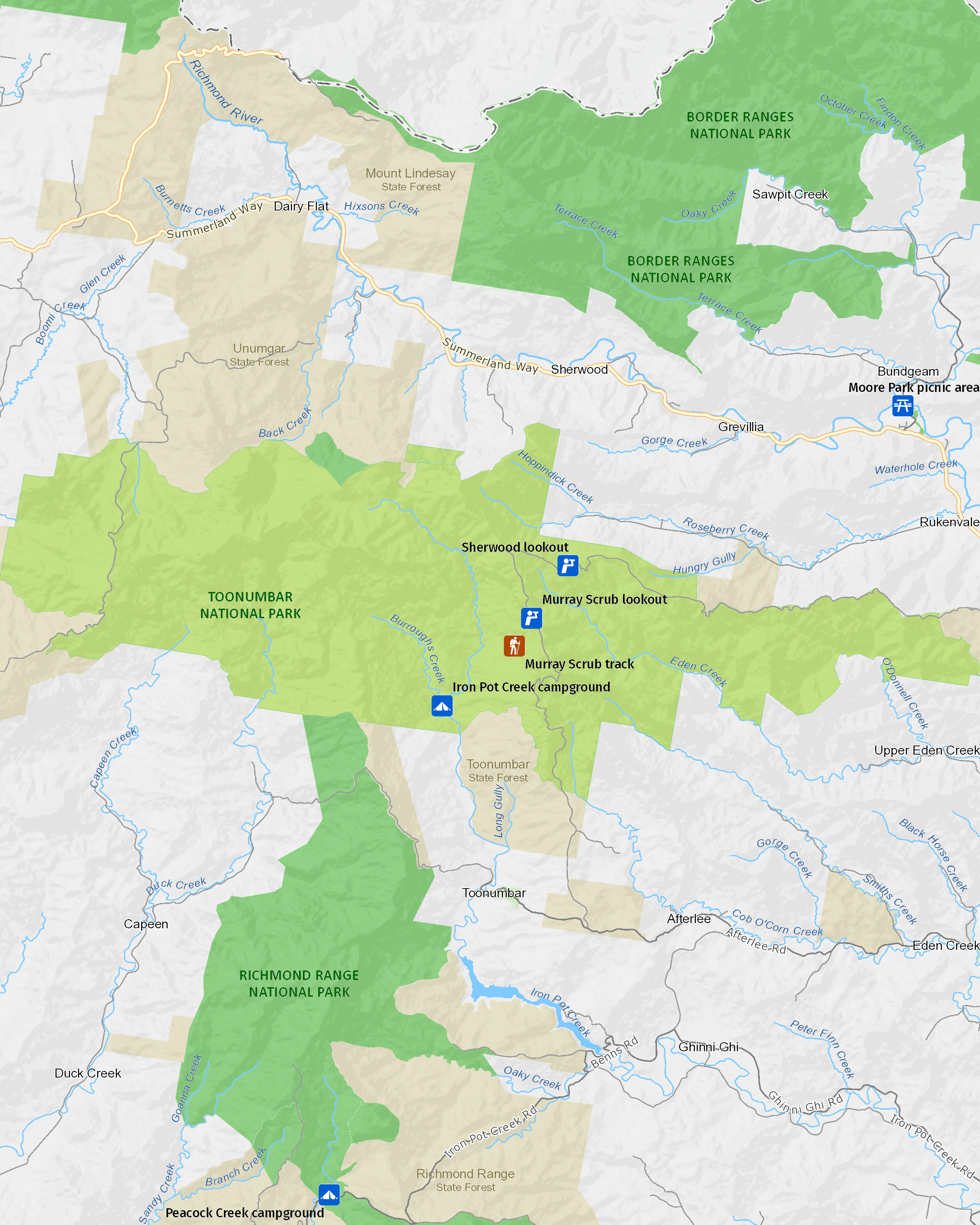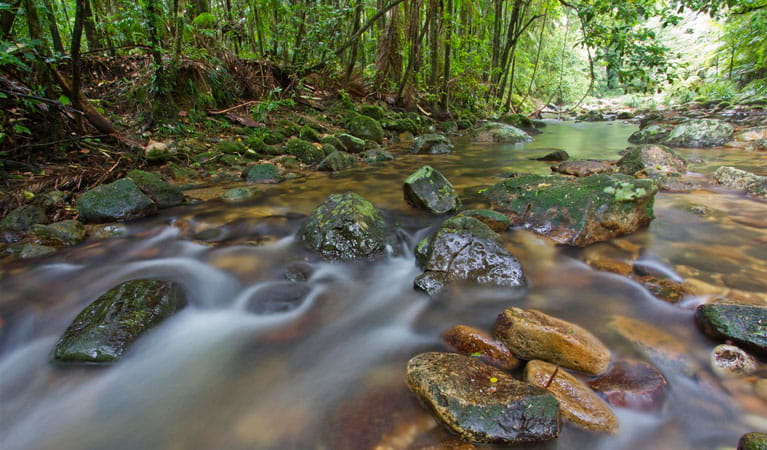Toonumbar National Park
Overview
Toonumbar National Park offers outstanding walking tracks, horse riding, picnic areas in World Heritage-listed gondwana rainforest, near Kyogle in northern NSW.
Read more about Toonumbar National Park
Summer, winter, or any time, there are loads of reasons to come to Toonumbar National Park in the Northern Rivers region of New South Wales – this park has it all.
Visit this beautiful park and be ready to experience World Heritage areas rich with Aboriginal heritage, abundant wildlife, an ancient volcano and incredible views. Go bushwalking along some great tracks, enjoy picnics, go birdwatching, camp beneath towering gums, or delight in some scenic horse riding.
All the different habitats in the park, from subtropical rainforests and pristine creeks to ancient eroded volcanic remains, are home to lots of amazing plant and animal species, including noisy paradise riflebirds and fruit-eating pigeons, owls, carpet pythons, koalas and red-necked pademelons.
Go in summer to camp by Iron Pot Creek and enjoy a refreshing swim, or on winter mornings watch mist rising above the rainforest and the eroded volcanic peaks from Murray Scrub lookout.
Local alerts
For the latest updates on fires, closures and other alerts in this area, see https://www.nationalparks.nsw.gov.au/visit-a-park/parks/toonumbar-national-park/local-alerts
Contact
- in the North Coast region
Toonumbar National Park is always open, but may have to close at times due to poor weather or fire danger.
-
-
Kyogle office
02 6632 0000
Contact hours: Monday to Friday, 8.30am to 4.30pm. - 136 Summerland Way, Kyogle NSW 2474
-
Email: npws.richmondriver@environment.nsw.gov.au
-
Kyogle office
Visitor info
All the practical information you need to know about Toonumbar National Park.
Map

Map legend

Getting there and parking
Get driving directions
From Kyogle:
- Leave the Summerland Way and travel west via Kyogle and Murray Scrub Road (approximately 35km)
- To reach the northern end of the park, take Coxs Road, which leaves the Summerland Way about 8km west of Grevillea to join Toonumbar Forest Drive.
Road quality
- Unsealed roads
Vehicle access
- 2WD vehicles
By bike
Check out the Bicycle information for NSW website for more information.
By public transport
There is no public transport available to Toonumbar National Park.
Best times to visit
There are lots of great things waiting for you in Toonumbar National Park. Here are some of the highlights.
Autumn
Take a spectacular scenic drive through the rainforest on Toonumbar Forest Drive Picnic at Sherwood lookout and soak up the spectacular views to Mount Lindesay and the McPherson Range .
Spring
Witness the burst of colour of new red leaf tips on giant red cedars from the soaring vantage point of the Murray Scrub lookout. Or gaze up at the glowing canopy from down below on the Murray Scrub walking track.
Summer
Camp at Iron Pot campground where you can drink from and swim in the pristine waters of Iron Pot Creek. On a hot summer day, enjoy a walk through the cool, shady rainforest at Murray Scrub walking track. .
Winter
Watch mist rise from the rainforest valleys below from Murray Scrub lookout.
Weather, temperature and rainfall
Summer temperature
Average
15°C and 30°C
Rainfall
Wettest month
February
Driest month
August
The area’s highest recorded rainfall in one day
210mm
Facilities
Toilets
Picnic tables
Barbecue facilities
Maps and downloads
Prohibited
Pets
Pets and domestic animals (other than certified assistance animals) are not permitted. Find out which regional parks allow dog walking and see the pets in parks policy for more information.
Smoking
NSW national parks are no smoking areas.
Nearby towns
Kyogle (24 km)
Kyogle is an attractive timber-milling town surrounded by rainforest. It's set on the Richmond River at the base of Fairy Mountain.
Casino (55 km)
Casino is a thriving rural centre in the heart of rich agricultural country. It's set in lush pastures on the banks of the Richmond River.
Lismore (70 km)
Lismore is a major North Coast commercial, cultural and administrative centre. It's set in undulating country on the north arm of the Richmond River.
Learn more
Toonumbar National Park is a special place. Here are just some of the reasons why:
World Heritage-listed rainforest

The rainforests of Murray Scrub and Dome Mountain of Toonumbar National Park are part of the Gondwana Rainforests of Australia World Heritage Area. With this incredible abundance of rainforests, your senses certainly won’t be short of things to take in. Keep your camera in hand and explore the vast rainforests along hiking trails. You’ll find white booyong, Bangalow palms, birds nest and staghorn ferns and rare rainforest vines in these forests. There’s also old growth forests of tallowwood and flooded gum.
- Murray Scrub lookout For easily-accessible scenic views of World Heritage-listed landscape in the Northern Rivers, the Murray Scrub lookout is not to be missed.
Wild-a-rama

Camping is a great way to take advantage of one of Toonumbar National Park’s most fantastic assets – its wildlife. The diverse plant life at this park makes it an ideal place for an equally diverse range of animals. You’ll find some super rare species here, such as spot-tailed quoll and red-legged pademelon. Other interesting species you might encounter are yellow-bellied gliders, koalas, small-eyed snakes and carpet pythons.
- Murray Scrub walking track Murray Scrub walking track is an easy and beautiful walk through shaded rainforest, accessible from Kyogle in Northern NSW.
Rocks of ages

Twenty-three million years ago, Toonumbar National Park was alive with volcanic activity. Now, the dormant, eroded volcano is the bedrock of a landscape that’s one of the most spectacular parks in New South Wales. The peaks of Dome Mountain (915m), Glassy Mountain (920m) and Edinburgh Castle (893m) are eroded remains from the Focal Peak shield volcano, the same one active 23 million years ago. Incredible views, extraordinary habitats and beautiful rock formations are its legacy.
- Murray Scrub lookout For easily-accessible scenic views of World Heritage-listed landscape in the Northern Rivers, the Murray Scrub lookout is not to be missed.
- Murray Scrub walking track Murray Scrub walking track is an easy and beautiful walk through shaded rainforest, accessible from Kyogle in Northern NSW.
Living Aboriginal history

Immerse yourself in Toonumbar National Park’s rich Aboriginal history. The park is part of the historic Githabul Nation native title claim. The area is traditional country of the Githabul People and almost wherever you look from the Murray Scrub and Sherwood lookout, these places are of deep, ongoing cultural significance. The forests and landscapes of the park are as physically rich as they are culturally; food, medicine, tools, weapons and shelter were derived from the land for thousands of years.
Nature’s own twitter

At any time, the peaceful rainforest can erupt in an incredible chorus of song – rare bird species such as sooty owls, white-eared monarchs and the Wompoo fruit-dove, all enjoy tweeting along to their favourite tune. The performance is not only great for birdwatchers to get a closer look at the wonderful birdlife, but also a soothing experience for all nature-lovers. Just don’t forget your binoculars.
- Murray Scrub walking track Murray Scrub walking track is an easy and beautiful walk through shaded rainforest, accessible from Kyogle in Northern NSW.
- Sherwood lookout Pack a picnic and spend some time at Sherwood lookout at Toonumbar National Park, Sherwood Ranges, with scenic views of an old volcano.
Plants and animals protected in this park
Animals
-

Albert's lyrebird (Menura alberti)
The Albert’s lyrebird is much rarer than the superb lyrebird. Distinguished by its richer brown plumage and less elaborate tail feathers, it’s protected as a threatened species in NSW.
Education resources (1)
What we're doing
Toonumbar National Park has management strategies in place to protect and conserve the values of this park. View the detailed park and fire management documents.

